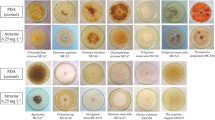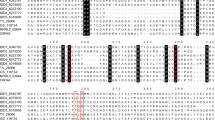Abstract
The fungal metabolism of 4-nitrophenol (4-NP) was investigated using the lignin-degrading basidiomycete, Phanerochaete chrysosporium. Despite its phenolic feature, 4-NP was not oxidized by extracellular ligninolytic peroxidases. However, 4-NP was converted to 1,2-dimethoxy-4-nitrobenzene via intermediate formation of 4-nitroanisole by the fungus only under ligninolytic conditions. The metabolism proceeded via hydroxylation of the aromatic ring and methylation of phenolic hydroxyl groups. Although the involvement of nitroreductase in the metabolism of 2,4-dinitrotoluene by many aerobic and anaerobic microorganisms including P. chrysosporium has been reported, no formation of 4-aminophenol was observed during 4-NP metabolism. The formation of 1,2-dimethoxy-4-nitrobenzene was effectively inhibited by exogenously added piperonyl butoxide, a cytochrome P450 inhibitor, suggesting that cytochrome P450 is involved in the hydroxylation reaction. Thus, P. chrysosporium seems to utilize hydroxylation and methylation reactions to produce a more susceptible structure for an oxidative metabolic system.



Similar content being viewed by others
References
Esteve-Nunez A, Caballero A, Ramos J (2001) Biological degradation of 2,4,6-trinitrotoluene. Microbiol Mol Biol Rev 65:335–352
Fernado T, Bumpus JA, Aust SD (1990) Biodegradation of TNT (2,4,6-trinitrotoluene) by Phanerochaete chrysosporium. Appl Environ Microbiol 56:1666–1671
Gold MH, Wariishi H, Valli K (1989) Biocatalysis in agricultural biotechnology. ACS symposium series 389. American Chemical Society, Washington, D.C., pp 127–140
Hallas LE, Alexander M (1983) Microbial transformation of nitroaromatic compounds in sewage effluent. Appl Environ Microbiol 45:1234–1241
Hirano T, Honda Y, Watanabe T, Kuwahara M (2000) Degradation of bisphenol A by the lignin-degrading enzyme, manganese peroxidase, produced by the white-rot basidiomycete, Pleurotus ostreatus. Biosci Biotechnol Biochem 64:1958–1962
Ichinose H, Wariishi H, Tanaka H (1999) Bioconversion of recalcitrant 4-methyldibenzothiophene to water-extractable products using lignin-degrading basidiomycete Coriolus versicolor. Biotechnol Prog 15:706–714
Jain RK, Dreisbach JH, Spain JC (1994) Biodegradation of p-nitrophenol via 1,2,4-benzenetriol by an Arthrobacter sp. Appl Environ Microbiol 60:3030–3032
Johjima T, Itoh N, Kabuto M, Tokimura F, Nakagawa T, Wariishi H, Tanaka H (1999) Direct interaction of lignin and lignin peroxidase from Phanerochaete chrysosporium. Proc Natl Acad Sci USA 96:1989–1994
Joshi DK, Gold MH (1993) Degradation of 2,4,5-trichlorophenol by the lignin-degrading basidiomycete Phanerochaete chrysosporium. Appl Environ Microbiol 59:1779–1785
Kirk TK, Farrel RL (1987) Enzymatic ‘combustion’: the microbial degradation of lignin. Annu Rev Microbiol 41:465–505
Kirk TK, Schultz E, Connors WJ, Lorenz LF, Zeikus JG (1978) Influence of culture parameters on lignin metabolism by Phanerochaete chrysosporium. Arch Microbiol 117:277–285
Li C, Hoffman MZ (1999) One-electron redox potentials of phenols in aqueous solution. J Phys Chem B 103:6653–6656
Mileski GJ, Bumpus JA, Jurek MA, Aust SD (1988) Biodegradation of pentachlorophenol by the white-rot fungus Phanerochaete chrysosporium. Appl Environ Microbiol 54:2885–2889
Munir E, Yoon JJ, Tokimatsu T, Hattori T, Shimada M (2001) New role for glyoxylate cycle enzymes in wood-rotting basidiomycetes in relation to biosynthesis of oxalic acid. J Wood Sci 47:368–373
Ohkura K, Hori H (1999) Analysis of structure-permeability correlation of nitrophenol analogues in newborn rat abdominal skin using semiempirical molecular orbital calculation. Bioorg Med Chem 7:309–314
Rieble S, Joshi DK, Gold MH (1994) Aromatic nitroreductase from the basidiomycete Phanerochaete chrysosporium. Biochem Biophys Res Commun 205:298–304
Reddy GVB, Gelpke MDS, Gold MH (1998) Degradation of 2,4,6-trichlorophenol by Phanerochaete chrysosporium: involvement of reductive dechlorination. J Bacteriol 180:5159–5164
Schackmann A, Muller R (1991) Reduction of nitroaromatic compounds by different Pseudomonas species under aerobic conditions. Appl Microbiol Biotechnol 34:809–813
Spain JC, Gibson DT (1991) Pathway for biodegradation of p-nitrophenol in a Moraxella species. Appl Environ Microbiol 57:812–819
Spain JC, Wyss O, Gibson DT (1979) Enzymatic oxidation of p-nitrophenol. Biochem Biophys Res Commun 88:634–641
Spain JC, Hughes JB, Knackmuss HJ (eds) (2000) Biodegradation of nitroaromatic compounds and explosives. Lewis, Boca Raton, pp 145–160
Stahl JD, Aust SD (1993) Plasma membrane dependent reduction of 2,4,6-trinitrotoluene by Phanerochaete chrysosporium. Biochem Biophys Res Commun 192:471–476
Stahl JD, Aust SD (1995) Properties of transplasma membrane redox system of Phanerochaete chrysosporium. Arch Biochem Biophys 320:369–374
Valli K, Gold MH (1991) Degradation of 2,4-dichlorophenol by the lignin-degrading fungus Phanerochaete chrysosporium. J Bacteriol 173:345–352
Valli K, Brock BJ, Joshi DK, Gold MH (1992) Degradation of 2,4-dinitrotoluene by the lignin-degrading fungus Phanerochaete chrysosporium. Appl Environ Microbiol 58:221–228
Wariishi H (2000) Fungal metabolism of environmentally persistent compounds: substrate recognition and metabolic response. Biotechnol Bioprocess Eng 5:422–430
Wariishi H, Gold MH (1990) Lignin peroxidase compound III: mechanism of formation and decomposition. J Biol Chem 265:2070–2077
Wariishi H, Morohoshi N, Haraguchi T (1987) Degradation of lignin by laccase isolated from Coriolus versicolor. Mokuzai Gakkaishi 11:892–898
Acknowledgement
This research was supported by a Grant-in-Aid for Scientific Research from the Japan Society for the Promotion of Science (to H.W.).
Author information
Authors and Affiliations
Corresponding author
Rights and permissions
About this article
Cite this article
Teramoto, H., Tanaka, H. & Wariishi, H. Degradation of 4-nitrophenol by the lignin-degrading basidiomycete Phanerochaete chrysosporium. Appl Microbiol Biotechnol 66, 312–317 (2004). https://doi.org/10.1007/s00253-004-1637-z
Received:
Revised:
Accepted:
Published:
Issue Date:
DOI: https://doi.org/10.1007/s00253-004-1637-z




